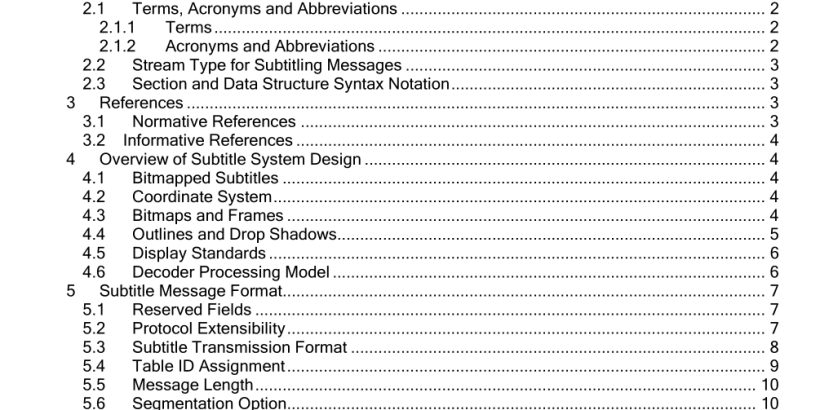ANSI SCTE 27-2016 pdf download.Subtitling Methods for Broadcast Cable
2.1.1 Terms
The following terms are used throughout this document: message: A sequence of bytes comprising a data structure defined in this Standard. All messages begin with the table_ID and end with the CRC_32 field. Messages are carried in non-PES streams; their starting points within a packet payload is indicated by the pointer_field mechanism defined in the ISO/IEC 13818-1 Systems document. section: A message comprising a portion of an ISO/IEC 13818-1-defined table, such as the Program Association Table (PAT), Conditional Access Table (CAT), or Program Map Table (PMT). The term conforms to MPEG terminology, but since it applies primarily to the delivery of table structures, the more appropriate term “message” is used to refer to non-table oriented data structures such as, for example, the subtitle message. program element: A generic term for one of the elementary streams or other data streams that may be included in a program. program: A collection of program elements. Program elements may be elementary streams. Program elements need not have any defined time base; those that do have a common time base and are intended for synchronized presentation. The term “program” is also used in the context of a “television program” such as a scheduled daily news broadcast. The distinction between the two usages should be understood by context. service: ISO/IEC 13818-1 uses the term “program” to refer to a collection of program elements without regard to time. In this Standard, the term “service” is used in this same context to denote a collection of elementary components. Usage of the term service clarifies certain discussions which also involve the notion of the term program in its traditional meaning (in, for example, the statement “A video service carries a series of programs”). stream: An ordered series of bytes. The usual context for the term “stream” involves specification of a particular PID (such as the “Program Map PID stream”).
4.5 Display Standards
Subtitles are authored with a specific display standard in mind (NTSC vs. PAL, HDTV vs. SDTV, etc.). The display standard used influences choices regarding text placement on the display grid. The targeted display standard is indicated in each subtitle message, given as the size of the display grid horizontally and vertically. Note that in some instances it may be possible to process a subtitle stream intended for one display standard on video of another. For example, it may be practical to define a service containing both an HDTV component and an SDTV component (dual carriage of video), but with just one subtitle stream. The stream would be formatted for NTSC display, to cover both cases. In this example, the NTSC version represents the least common denominator between the two formats. It is the responsibility of the HDTV Decoder to scale the vertical position based on vertical resolution, and adjust positions horizontally, as appropriate, in order to accommodate the foreign-format subtitle. For horizontal placement of bitmap or text objects, the 720 NTSC pixels would be centered within the HDTV display region. The actual sizes of bitmaps and frames shall not be required to be scaled except by a factor of two (line doubling). Specification of specific requirements for support of foreign-format subtitles are outside the scope of this Standard.
MPEG-2 Transport Stream packets come into the model at the left, and are filtered by PID. Packets whose PID matches the target value flow into the 512 byte transport buffer. These buffered packets are removed at a rate of 32 kbps (kilobits/second) for depacketization and desegmentation, and the result is stored in the input buffer as the data input to the subtitling application. In the case of segmented subtitle messages (see descriptions in Section 4.6), only completely reassembled messages should be kept for subsequent processing. Incomplete messages shall be discarded. Subsequent processing of each reassembled message includes decompression, rendering, and queuing for display at the specified in-cue time. In order to define the input buffer and display queue sizes, maximum data sizes for uncompressed and rendered subtitles are defined. Although derived from the NTSC display standard, the same maxima are also assumed for other display standards.ANSI SCTE 27-2016 pdf download
